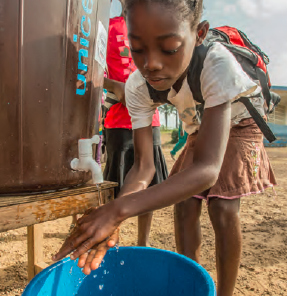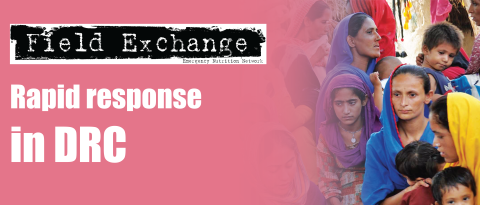Beyond the drinking glass: expanding our understanding of water-nutrition linkages
By Dawit Mekonnen, International Food Policy Research Institute
Dawit Mekonnen is a Research Fellow at the International Food Policy Research Institute (IFPRI) in the Environment and Production Technology Division. His current research in sub-Saharan Africa focuses on understanding the impact of irrigation on agricultural productivity, nutrition, health and women’s empowerment under the Feed the Future Innovation Lab for Small-Scale Irrigation, a bilateral activity under the CGIAR Research Programme on Water, Land and Ecosystems.
 Water access and management play central roles in determining nutritional outcomes. Water-for-nutrition is most often approached from a WASH (water, sanitation and hygiene) perspective, where the aim is to improve water quality and practices for domestic water supply, thus reducing the burden of water-related diseases in a population. A WASH focus for improving nutritional outcomes is especially pertinent, given recent evidence highlighting the role of diarrhoeal disease and environmental enteropathy in determining child stunting. However, there are a number of water-nutrition pathways in addition to WASH that would benefit from greater attention in research and discussion. A session aimed at expanding our understanding of water-nutrition linkages was organised during the 2016 Stockholm World Water Week (26 August to 5 September, 2016). The session was organised by the International Food Policy Research Institute (IFPRI) in collaboration with the Center for Development Research (ZEF) at the University of Bonn, USAID, and Texas A&M University.
Water access and management play central roles in determining nutritional outcomes. Water-for-nutrition is most often approached from a WASH (water, sanitation and hygiene) perspective, where the aim is to improve water quality and practices for domestic water supply, thus reducing the burden of water-related diseases in a population. A WASH focus for improving nutritional outcomes is especially pertinent, given recent evidence highlighting the role of diarrhoeal disease and environmental enteropathy in determining child stunting. However, there are a number of water-nutrition pathways in addition to WASH that would benefit from greater attention in research and discussion. A session aimed at expanding our understanding of water-nutrition linkages was organised during the 2016 Stockholm World Water Week (26 August to 5 September, 2016). The session was organised by the International Food Policy Research Institute (IFPRI) in collaboration with the Center for Development Research (ZEF) at the University of Bonn, USAID, and Texas A&M University.
Outline of the session
The session was organised to strengthen insights on the interaction between sectors not often linked: nutrition, gender, irrigation, WASH and agriculture. It started off with an interactive activity where participants wrote down components of the water-nutrition “system” on note cards. This provided the more than 75 participants from universities, government agencies, research institutes, intergovernmental organisations, non-governmental organisations (NGOs), civil societies and the private sector the opportunity to identify potential pathways from water to nutrition from their respective vantage points.
The information gathered is expected to enrich the conceptual framework that IFPRI uses on water-for-nutrition linkages. The interactive session was followed by four oral presentations and discussions on irrigation-nutrition linkages: Insights from the Innovation Lab for Small Scale Irrigation (ILSSI) Project and Beyond by Dawit Mekonnen of IFPRI; Agriculture, Water Quality, Nutrition and Health by Muhammed Abdella Usman of ZEF; Multiple-Use Water Services and Improved Dietary Diversity in Rural Tanzania and Burkina Faso by Sara Marks of Eawag (the Swiss Federal Institute of Aquatic Science and Technology); and Improving Community-Led Total Sanitation through Experimental Games by Yaniv Stopnitzky of University of San Francisco.
Key findings
The presentation on irrigation-nutrition linkages by researchers from IFPRI explored the major potential pathways through which irrigation can influence nutritional status. These potential pathways include: the production pathway, where irrigation provides the opportunity to grow in the lean season to increase production of animal foods through irrigated fodder and improve crop yields (especially with improved varieties and complementary inputs); the income pathway, since irrigation usually leads to higher gross revenue per hectare for small scale irrigators as it is used mainly for cash crops; the water-supply pathway, as irrigation water may be used for other purposes such as drinking, washing, bathing or other productive purposes (such as livestock watering and aquaculture); the health-risks pathway, where negative relationship between irrigation and nutrition may arise from increased risk of vector-borne diseases (such as malaria and dengue), depending on the source of water for irrigation and method of water application; and the gender pathway, where irrigation projects targeted at women may have differential impact on nutrition and health outcomes. This is because women may allocate resources gained from the sale of irrigated crops to food and health expenditures or use irrigation to grow more nutritious foods for home consumption, or because irrigation may directly contribute to women’s empowerment (for instance, by increasing assets owned or income controlled by women), but have a potential negative effect due to time burden (depending on the type of irrigation technology or source of irrigation water).
The preliminary findings from an econometric analysis of irrigation-nutrition linkages by the team from IFPRI using data from the ILSSI project in Ethiopia and Tanzania showed that access to irrigation significantly improves both household income and the diversity of crops that farmers produce. Increasing household income led in turn to higher dietary diversity, suggesting that the income pathway between irrigation and nutrition is at play; whereas the relationship between production diversity and dietary diversity is not statistically significant after controlling for the income effect of irrigation. Although further research is needed on why production diversity from irrigation does not directly translate into higher dietary diversity, the researchers hypothesize that this is possibly due to forgone income benefits from specialisation as farmers in the sample are, on average, producing up to seven different crops on cultivated land of less than two hectares.
The research from Eawag explores the impact of multiple-use water services (MUS) on the health and diet of rural households based on controlled-impact evaluation of two MUS programmes in rural Africa. The WA-WASH programme in Burkina Faso and the iWASH programme in Tanzania both delivered integrated water services to improve access to drinking water, support vegetable gardens, animal husbandry and many other activities. Results show that whereas food insecurity existed to some extent in all communities, the number of households self-identifying as food insecure was significantly lower in communities receiving MUS. In addition, a slight improvement in overall dietary diversity was observed in Tanzania as a result of MUS. The research also found that animal-product consumption improved significantly as a result of MUS. Data for this study were sourced from USAID and the GLOWS programme, with support from Winrock, Florida International University and Eawag.
The research from ZEF brings another important dimension to the overall discussion as it explores the linkages between agriculture, water quality, nutrition and health using data from two districts in Ethiopia. The data from the two districts show that although households with access to irrigation have slightly better access to drinking water, spend less time collecting water and have higher per capita water consumption compared to non-irrigating households, the level of E. Coli per 100 ml of drinking water and exposure to malaria was higher among irrigators than non-irrigators. Irrigators in the sample had a higher overall morbidity than non-irrigators and children of irrigating households are more likely to be undernourished than children of non-irrigators. A significant number of households reported that they directly draw water from irrigation sources for household consumption. Similarly, household members working on an irrigated field may contaminate domestic water sources if proper personal hygiene and handwashing are lacking.
The research from University of San Francisco aimed to explore whether experience of playing a short experimental game, which was designed to mimic strategic interdependencies in sanitation and hygiene behaviour, might alter related preferences and behaviour. Looking at a cross-section of data, the authors were unable to ascertain whether playing the experimental game alters real-world behaviour, although they intend to pursue this question with follow-up surveys. However analysis of the game shows strong evidence that even a short, structured game can significantly alter a large set of preferences around sanitation and hygiene, and importantly at a very low cost compared to other types of interventions. See also: www.ifpri.org/publication/changing-preferences-through-experimental-games-evidence-sanitation-and-hygiene-tamil
Discussion and conclusions
The session has brought to light different dimensions of water-nutrition linkages. The main theme underlying all the presentations and discussion in the session is that agriculture-water-sanitation-nutrition linkages form a complex system that requires a mix of multiple instruments for success.
Given the complexity of these linkages, analysing a single pathway may lead to misleading policy recommendations. Analysis therefore calls for a cautionary approach that exploits synergies and reduces trade-offs among potential causal linkages. For instance, small-scale irrigation can lead to higher nutritional status (measured as dietary diversity and food security), but the nutrition and food security dividend from small-scale irrigation requires that health, sanitation, nutrition and gender considerations are actively promoted during the design and implementation of irrigation development. On the other hand, widespread household water contamination in rural areas can undermine the progress made in increasing access to improved water supply in many developing countries.
The presentations and discussions in the session showed that the numerous pathways linking water, nutrition and gender are still insufficiently understood and call for the water, gender and nutrition sectors to work together to develop rigorous research exploring efficient approaches and to collaborate in developing effective programmes and policies to better ensure that the related Sustainable Development Goals (SDG) of zero hunger, gender equality and clean water and sanitation are achieved.
For more information, contact: Dawit Mekonnen, email: d.mekonnen@cgiar.org


